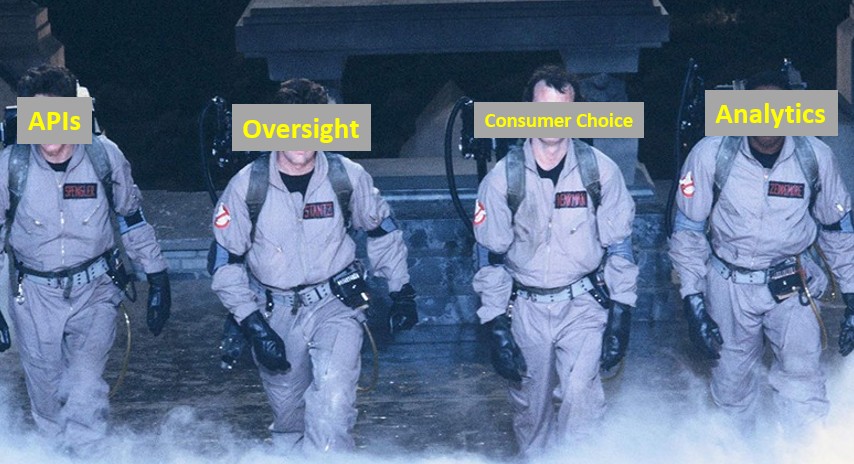In our last article, we explored mental health ‘ghost’ networks as discussed in the May 3rd Senate Finance Committee hearing. We summarized the multiple causes of the problem and potential solutions. In this piece, we will explore how existing interoperability requirements for payer directories can be leveraged to support new solutions.
The specific requirements we’ll review are a) the Provider Directory APIs required by the CMS Final Rule enforceable as of July 2021, and b) the previously required Provider Directory machine readable files for Exchange plans. These rules require payers to publish provider directory data in publicly available APIs and machine readable files. The data includes information you would expect to see in a payer’s web directory: names of providers, addresses, phone numbers, their specialties, the plans they participate in, and whether they are accepting new patients.
To demonstrate the opportunities with public, machine-readable data, we created the map below of Fairfax County, Virginia and the top 5 payers in each zip code by % of available mental health providers in-network.
Top 5 Exchange Networks in Each Fairfax County Zip Code by % of Mental Health Providers In-Network
We created the above interactive map and the underlying stats by leveraging data from machine-readable files from each payer that offers Exchange plans in Fairfax County. For each zip code in the county, we counted the number of mental health providers (including psychiatrists, therapists, counselors, psychologists, and social workers) who had practice locations within that zip code and accepted any Exchange plan. This value served as the denominator of mental health providers within the zip code. Then, for each plan that had providers in that zip code, we summed up the providers and calculated that as a percentage of total mental health providers in the zip code. Then we ranked each payer network by the percentage and count, and created the above map with the overlayed statistics.
Observations:
- In some zip codes (e.g., 22030, 22031, 22182, 22043, 20124, 20120), the top 5 payers are in a relatively tight range of provider coverage (e.g., between 35% and 47% of all providers).
- In most zip codes, one or two networks significantly outperform the remainder (e.g., in 22312, the drop from top payer to 5th is 71% to 13%), meaning that members of the underperforming plans may have relatively low access to mental health providers and have to travel or wait longer to find one who participates in their network.
- Anthem HealthKeepers ranked #1 in 14 zip codes. CareFirst ranked #1 in 11 zip codes.
The analysis above was conducted without performing any additional validation on whether providers are practicing at the locations listed, or whether they are accepting new patients with the plan that listed them. The limitations of payer directory data discussed in the previous article remain. Nevertheless, there is considerable value in being able to access a payers’ directory data, analyze it, and compare relative network robustness in a programmatic way. Such a dashboard could help consumers make decisions on the best plan, or help payers to see where they may have mental health network gaps.
Other ways Provider Directory API data can help improve mental health networks and access:
| Participant | Solution Concept |
| Regulators | 1. Conduct network reviews more frequently than currently required with HSD table submissions. 2. Perform accuracy audits more frequently and efficiently with data from Provider Directory APIs. – Machine-readable data can be more easily ingested into audit workflows – ‘Secret shopper’ phone auditors can be more quickly deployed against timely data 3. Produce accuracy scores and apply them to health plan networks. |
| Payers | 1. Apply the same ‘secret shopper’ approaches to assess their own directory accuracy. 2. Bump up claims data against directory data in API to detect ‘ghosts’. 3. See where other payers agree or disagree in terms of provider @ location to correct errors. 4. Assess network robustness of their plans against other plans in the same market. 5. See where their network needs to expand and employ strategic recruiting efforts. |
| Consumers | 1. Use information on relative mental health network size to shortlist plans to consider. 2. Use third-party provider search workflows with ‘insurances’ filter leveraging API data. |
Provider Directory APIs may not solve for some causes of mental health ghost networks (for example, workforce scarcity and payment parity). However, the data in these APIs can play an important role in regulatory oversight, data quality improvement, and consumer decision making. And, as we optimistically see interventions implemented, the APIs can be used to measure network growth and their ability to deliver care to patients over time.
Legislators and regulators at both the national and state level should consider how already-built APIs can be used. Payers have spent millions of dollars to build Provider Directory APIs to comply with CMS rules. Nearly two years since enforcement, directory APIs are widespread, with most payers having published functioning APIs. Let’s put them to work!
